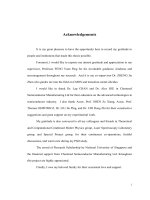Studies on genetic variability, heritability and genetic advance in F2 segregating population of Cross Arka Archana × AAC-1 in China Aster [Callistephus chinensis (L.) Nees]
Bạn đang xem bản rút gọn của tài liệu. Xem và tải ngay bản đầy đủ của tài liệu tại đây (163.06 KB, 4 trang )
Int.J.Curr.Microbiol.App.Sci (2019) 8(4): 1230-1233
International Journal of Current Microbiology and Applied Sciences
ISSN: 2319-7706 Volume 8 Number 04 (2019)
Journal homepage:
Original Research Article
/>
Studies on Genetic Variability, Heritability and
Genetic Advance in F2 Segregating Population of Cross Arka
Archana × AAC-1 in China Aster [Callistephus chinensis (L.) Nees]
H.M. Ramya, S.K. Nataraj*, D. Lakshmana and Rajiv Kumar
Department of Floriculture and Landscape Architecture, College of Horticulture,
Mudigere 577132, India
*Corresponding author
ABSTRACT
Keywords
China aster,
Variability,
Heritability and
Genetic advance
Article Info
Accepted:
10 March 2019
Available Online:
10 April 2019
The present study was conducted to evaluate genetic variability in F2 population of cross
Arka Archana × AAC-1 in China aster at the College of Horticulture, Mudigere during
2017-18. The phenotypic coefficient of variation was higher than genotypic coefficient of
variation for all the traits. High (>20 %) phenotypic coefficient of variation (PCV) and
genotypic coefficient of variation(GCV) was recorded for number of branches per plant,
plant spread East-West, number of flowers per plant, disc diameter, individual flower
weight and flower yield per plant. High heritability (>60 %) coupled with high genetic
advance as per cent over mean (>20 %) were recorded for plant height, number of
branches per plant, plant spread North-South and East-West, flower diameter, disc
diameter, flower stalk length and flower yield per plant and indicated that the high
heritability is due to additive gene effects which can be utilized for further crop
improvement programme.
approximately 10 per cent as reported by
Fleming (1937).
Introduction
China aster [Callistephus chinensis (L.)
Nees.] is a half-hardy annual and an important
commercial flower crop belonging to the
family Asteraceae with chromosome number
of (2n = 18). The genus Callistephus is
derived from two Greek words Kalistos
meaning ‘most beautiful’ and Stephos ‘a
crown’ referring to the flower head. Among
annuals china aster ranks next to
chrysanthemum and marigold. China aster is a
self pollinated crop but the natural crossing is
The success of any crop improvement
depends on the genetic variability existing in
the available genotypes, which may be either
due to genetic constitution of cultivars or
variation in the growing environment.
Creation and utilization of the variability
using proper breeding procedure is the prerequisite for genetic improvement of any
crop. Generally, amount of variability
generated is more in the early segregating
1230
Int.J.Curr.Microbiol.App.Sci (2019) 8(4): 1230-1233
generations than compared to later
generations. Hence, segregating F2 population
provides an opportunity for selection of
desirable segregants. Being a self pollinated
crop, there is need of high yielding variety of
china aster with specific colored flowers.
Hence keeping all these in view, the present
study was undertaken to examine the
magnitude of variability, heritability, genetic
advance, and genetic advance as percent mean
for different growth, flowering, quality and
yield parameters among segregating F2
populations.
Materials and Methods
The present experiment was carried out in the
Department of Floriculture and Landscape
Architecture, College of Horticulture,
Mudigere, University of Agricultural and
Horticultural Sciences, Shivamogga during
2017-18. The Experiment consists of 200 F2
populations of cross Arka Archana and AAC1, F1 and their parents viz., Arka Archana and
AAC-1. The F2 population is obtained from
selfing F1 hybrids of Arka Archana × AAC-1.
Experiment was laid out in unreplicated
design. Thirty days old rooted cuttings were
transplanted in 30 x 30 cm spacing and all the
recommended
agronomic
package
of
practices were followed. Observations were
recorded in all the F2 populations for different
growth, flowering, yield and quality
parameters. The parameters of variability like
mean, range, phenotypic and genotypic
coefficient of variation (As per the Burton and
De-Vane, 1953), broad sense heritability
(Johnson et al, 1955) and genetic advance
were calculated according to Johnson et al.,
(1955).
Results and Discussion
The F2 population of the cross Arka Archana
× AAC-1 was found to be significantly
superior for most of the characters studied.
The estimates of phenotypic coefficient of
variation values were relatively higher than
those of genotypic coefficient of variation for
all the traits (Table 1) which indicated greater
genotype × environment interactions.
The estimates of PCV (phenotypic coefficient
of variation) and GCV (genotypic coefficient
of variation) were high (> 20%) for number of
branches per plant (30.25 % and 23.41 %),
plant spread East-West (22.07% and 21.30%),
number of flowers per plant (26.02 % and
25.30%), disc diameter (34.08% and 33.33%),
individual flower weight (25.59% and
25.18%) and flower yield per plant (30.54%
and 29.99%) indicating wider variation in the
population and less environmental influence
on the expression of traits. Similar findings
were recorded by Harishkumar et al., (2017)
and Rai et al., (2017) in china aster, Prakash
et al., (2017) and Telem et al., (2017) in
chrysanthemum. This indicated that the
characters showing higher magnitude of
coefficient of variation offer better
opportunity for improvement through
selection and moderate PCV and GCV were
recorded for plant height (17.58% and
15.78%), stem girth (16.88% and 10.56%),
duration of flowering (13.78% and 10.63%),
flower diameter (11.73% and 11.35%), flower
stalk length (19.20% and 15.58%), indicating
environmental influence on the expression of
the traits with little or high difference in PCV
and GCV (Table 1). This is in accordance
with the findings of Rajiv et al., (2014) and
Harishkumar et al., (2017) in china aster.
Low PCV and GCV were recorded for days to
flower bud initiation (6.87% and 6.48%), days
to first flowering (6.11% and 5.46%), shelf
life (8.50% and 4.80%) and vase life (12.87%
and 7.18%) This is in agreement with the
findings of Harishkumar et al., (2017) in
china aster, Vikas et al., (2015) in dahlia
(Table 1). High heritability coupled with high
genetic advance as per cent of mean was
1231
Int.J.Curr.Microbiol.App.Sci (2019) 8(4): 1230-1233
recorded for plant height (80.50% and
29.17%), number of branches per plant
(63.82% and 39.15%), plant spread NorthSouth (87.33% and 38.46%), plant spread
East-West (93.18% and 42.37%), flower
diameter (93.74% and 22.65%), disc diameter
(95.61% and 67.13%), flower stalk length
(65.83% and 26.04%) and flower yield per
plant (96.39% and 81.53%) indicating
usefulness of these traits in selection of
desirable segregants due to its genetic control
by additive gene action (Table 1). These
results are in agreement with the findings of
Khangjarakpam et al., (2014) in China aster,
Telem et al., (2017) in chrysanthemum.
Table.1 Mean, range, genetic components of variance, heritability and genetic advance on
different growth, flowering, quality and yield parameters in F2 population of cross Arka Archana
× AAC-1 in China aster
GV
88.17
PCV(%)
17.58
GCV (%)
15.78
h2 (%)
80.50
GA
17.35
GAM
29.17
109.52
7.05
4.50
30.25
24.20
63.82
3.43
39.15
0.42-0.98
20-60
18-48
0.012
57.23
52.05
0.005
49.98
48.50
16.88
21.38
22.07
10.56
19.98
21.30
39.18
87.33
93.18
0.09
13.61
13.84
13.62
38.46
42.37
58.66
50-67
16.26
14.46
6.87
6.48
88.93
7.38
12.59
65.75
77.28
57-74
59-87
16.17
24.58
12.92
23.28
6.11
6.41
5.46
6.24
79.91
94.71
6.62
9.67
10.07
12.51
Duration of flowering
(days)
Flower diameter (cm)
34.09
27-44
22.09
13.14
13.78
10.63
59.48
5.75
16.89
5.44
3.8-6.9
0.40
0.38
11.73
11.35
93.74
1.23
22.65
Disc diameter (cm)
Flower stalk length (cm)
Vase life (days)
Shelf life (hours)
Number of flowers per
plant
Individual flower weight
(g)
Flower yield (g/plant)
Flower yield (q/ha)
1.32
20.60
8.10
30.21
45.91
0.6-2.3
13-30
6-10
25-37
21-78
0.20
15.65
1.08
6.60
142.71
0.19
10.30
0.33
2.10
135.01
34.08
19.20
12.87
8.50
26.02
33.33
15.58
7.18
4.80
25.30
95.61
65.83
31.15
31.84
94.60
0.89
5.36
0.66
1.68
23.28
67.13
26.04
8.26
5.58
50.71
2.68
1.4-5.7
0.47
0.45
25.59
25.18
96.82
1.37
51.04
120.98
134.42
43.8-188.8
48.66-209.77
1365.68
1686.02
1316.46
1625.25
30.54
30.54
29.99
29.99
96.39
96.39
73.38
81.53
81.53
60.65
Character
Plant height (cm)
Mean
59.5
Range
30-87
Number of branches per
plant
Stem girth (cm)
Plant spread (N-S) (cm)
Plant spread (E-W)(cm)
8.76
5-18
0.67
35.38
32.68
Days to flower bud
initiation
Days to first flowering
Days to 50% flowering
PV
PCV- Phenotypic Co-efficient of Variation GCV- Genotypic Co-efficient of Variation
h2- Heritability in broad sense
PV- Phenotypic Variance
GAM- Genetic advance as per cent of mean
Moderate heritability with moderate to high
genetic advance as per cent mean was observed
for stem girth (39.18% and 13.62%), duration of
flowering (59.48% and 16.89%), vase life
(31.15% and 8.26%) and shelf life (31.84% and
GV- Genotypic Variance
GA-Genetic Advance
5.58%) indicating non-additive gene action
(Table 1). These results are in accordance with
the findings of Khangjarakpam et al., (2014)
and Rajiv et al., (2014) in china aster, Ghimiray
and Sarkar (2015) in gerbera. High heritability
1232
Int.J.Curr.Microbiol.App.Sci (2019) 8(4): 1230-1233
along with genetic advance increases the
efficiency of selection in a breeding programme
by assessing the influence of environmental
factors and additive gene action.
In conclusion, present study revealed that there
was a wide range of variability existed in cross
Arka Archana × AAC-1 for different growth,
flowering, quality and yield parameters. Plants
which exhibited different characters with high
heritability coupled with high genetic advance
would be effective for selection and utilized for
breeding of high yielding China aster cultivars.
Acknowledgement
The authors sincerely acknowledge department
of Floriculture and Landscape Architecture for
providing the facilities.
References
Burton, G. W. and Devane, E. M. 1953.
Estimating heritability from replicated
clonal material. Agronomy Journal. 45:
478-481.
Fleming, W. M. 1937. U. S. D. A. Year book of
Agriculture, U. S. Department of
Agriculture, p985.
Ghimiray, T. S. and Sarkar, I. 2015. Studies on
genetic variability in Gerbera (Gerbera
jamesonii). Int. J. Bioresource Sci. 2(2):
81-83.
Harishkumar, K., Shiragur, M., Kulkarni, B. S.
and Patil, B. C. 2017. Studies on genetic
variability, heritability and genetic
advance in F2 segregating population of
china aster [Callistephus chinensis L.
(Nees.)]. Agric. Res. J. 54(3): 407-409.
Johnson, H. W., Robinson, H. F. and Constock,
R. E. 1955. Estimate of genetic and
environmental variability in Soyabeans.
Apron. J. 47: 314-318.
Khangjarakpam, G., Rajiv Kumar., Seetharamu,
G. K., and Rao, M. T. 2014. Genetic
variability for quantitative traits in China
aster [Callistephus chinensis (L.) Nees].
J. Hort. Sci. 9(2): 141-144.
Prakash, A., Kumar, M., Sirohi, U., Singh, M.
K., Malik, S., Kumar, V., Rana, A. and
Maurya, O. P. 2017. Assessment of
genetic variability, heritability and
genetic advance in chrysanthemum
(Dendranthema grandiflora Tzvelev.).
Hort. Flora Res. Spectrum. 6(3): 212-214.
Rai, T. S., Chaudhary, S. V. S., Dhiman, S. R.,
Dogra, R. K. and Gupta, R. K. 2017.
Genetic variability, character association
and path coefficient analysis in China
aster (Callistephus chinensis). Indian J.
Agric. sci. 87(4):540-543.
Rajiv, K., Gayatri, K., Manjunatha, R. T. and
Dhananjaya, M. V. 2014. Genetic
variability for quantitative traits in China
aster. Agro. Technol. 2(4): 105-110.
Telem, R. S., Sadhukhan, R., Sarkar, H. K.,
Akoijam, R., Haribhushan, A. and Wani,
S. H. 2017. Genetic studies for flower
yield
and
component
traits
in
Chrysanthemum morifolium Ramat. J.
Applied Natural Sci. 9(1): 211 – 214.
Vikas, H. M., Patil, V. S. Agasimani, A. D. And
Praveenkumar, D. A. 2015. Studies on
genetic variability in Dahlia (Dahlia
variabilis L.). I. J. S. N. 2(2): 372-375.
How to cite this article:
Ramya, H.M., S.K. Nataraj, D. Lakshmana and Rajiv Kumar. 2019. Studies on Genetic Variability,
Heritability and Genetic Advance in F2 Segregating Population of Cross Arka Archana × AAC-1 in
China Aster [Callistephus chinensis (L.) Nees]. Int.J.Curr.Microbiol.App.Sci. 8(04): 1230-1233.
doi: />
1233









![Genetic variability, diversity and character association in sponge gourd [Luffacylindrica (Roem.) L.]](https://media.store123doc.com/images/document/2020_01/13/medium_tig1578934486.jpg)